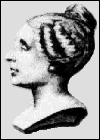| 2Z
|
|
integral domain, not a field
|
| quaternions
|
|
integral domain and field
|
| unit quaternions
|
|
ring which is abelian under *, has a mult id, but is not an integral domain
|
| symetries of tetrahedron
|
|
ring which is abelian under *, has no zero divisors, but is not an integral domain
|
| Z_6
|
|
non-abelian group, not a ring
|
| Z
|
|
ring which has no zero divisors, has a mult id, but is not an integral domain
|
| Z_p, where p is prime
|
|
abelian group, not a ring
|
| 2Z
|
--> |
ring which is abelian under *, has no zero divisors, but is not an integral domain
| Correct |
| quaternions
|
--> |
ring which has no zero divisors, has a mult id, but is not an integral domain
| Correct |
| unit quaternions
|
--> |
non-abelian group, not a ring
| Correct |
| symetries of tetrahedron
|
--> |
abelian group, not a ring
| Correct |
| Z_6
|
--> |
ring which is abelian under *, has a mult id, but is not an integral domain
| Correct |
| Z
|
--> |
integral domain, not a field
| Correct |
| Z_p, where p is prime
|
--> |
integral domain and field
| Correct |
| a,b,c in R, a not 0, ab=ac implies b=c
|
|
Let R=Z_6={0,1,2,3,4,5}.
Take a=0, b=1. Notice that a,b in R, ab=0*1=0 and a=0, as desired.
|
| a,b, in R, ab=0 implies a=0 or b=0
|
|
Let R=Z_6={0,1,2,3,4,5}.
Take a=2, b=1, c=4. Notice that a,b,c in R and a not 0.
Also, ab=2*1=2=2mod6=8mod6=2*4=ac, but 1 is not equal to 4, as desired.
|
| a in R implies, a not 0, a^2 = a implies a=0 or a=1.
|
|
Let R=Z_6={0,1,2,3,4,5}.
Take a=4. Notice a in R, a not 0, a^2=4^2=16=4mod6 and a not 0 and a not 1, as desired.
|
| There exists R, there exists a,b, in R s.t.
ab=0 and (a=0 or b=0)
|
|
Let R=Z_6={0,1,2,3,4,5}. Take a=2, b=1, c=1. Notice a,b,c in R, a not 0, ab=2*1=2=2*1=ac and b=1=c, as desired.
|
| There exists R, there exists a in R s.t. a not 0, a^2=a and
(a=0 or a=1)
|
|
Let R=Z_6={0,1,2,3,4,5}.
Take a=2, b=3. Notice that a,b in R and ab=2*3=6=0mod6 and
2 is not 0 and 3 is not 0, as desired.
|
| There exists R, there exists a,b,c in R s.t. a not 0, ab=ac and b=c.
|
|
Let R=Z_6={0,1,2,3,4,5}.
Take a=1. Notice a in R, a not 0, a^2=1^2=1, and a=1, as desired.
|
| a,b,c in R, a not 0, ab=ac implies b=c
|
--> |
Let R=Z_6={0,1,2,3,4,5}.
Take a=2, b=1, c=4. Notice that a,b,c in R and a not 0.
Also, ab=2*1=2=2mod6=8mod6=2*4=ac, but 1 is not equal to 4, as desired.
| Correct |
| a,b, in R, ab=0 implies a=0 or b=0
|
--> |
Let R=Z_6={0,1,2,3,4,5}.
Take a=2, b=3. Notice that a,b in R and ab=2*3=6=0mod6 and
2 is not 0 and 3 is not 0, as desired.
| Correct |
| a in R implies, a not 0, a^2 = a implies a=0 or a=1.
|
--> |
Let R=Z_6={0,1,2,3,4,5}.
Take a=4. Notice a in R, a not 0, a^2=4^2=16=4mod6 and a not 0 and a not 1, as desired.
| Correct |
| There exists R, there exists a,b, in R s.t.
ab=0 and (a=0 or b=0)
|
--> |
Let R=Z_6={0,1,2,3,4,5}.
Take a=0, b=1. Notice that a,b in R, ab=0*1=0 and a=0, as desired.
| Correct |
| There exists R, there exists a in R s.t. a not 0, a^2=a and
(a=0 or a=1)
|
--> |
Let R=Z_6={0,1,2,3,4,5}.
Take a=1. Notice a in R, a not 0, a^2=1^2=1, and a=1, as desired.
| Correct |
| There exists R, there exists a,b,c in R s.t. a not 0, ab=ac and b=c.
|
--> |
Let R=Z_6={0,1,2,3,4,5}. Take a=2, b=1, c=1. Notice a,b,c in R, a not 0, ab=2*1=2=2*1=ac and b=1=c, as desired.
| Correct |
1. Niels Abel

|
|
a. proved that x^5+y^5=z^5 has no non-zero whole number solutions.
|
2. Marjorie Lee Browne

|
|
b. The quaternions are a ring that are not abelian under multiplication since ij=k, but ji=-k
|
3. Julius Wihelm Richard Dedekind

|
|
c. When we adjoin
any root r of
f(x)=x^6+6x^5+17x^4+32x^3+37x^2+26x+6
to the complex numbers C,
we still get C. I.e.
C(r)=C for all roots r.
|
4. Leonhard Euler

|
|
d. Proved the Epsilon Conjecture which says that Taniyama-Shimura implies Fermat's Last Theorem
|
5. Pierre de Fermat

|
|
e. mentions the equation 8x8x8x8=4 in the cut "As" from Songs in the Key of Life.
|
6. Lodovico Ferrari
|
|
f. Z_3 is a finite field
|
7. Evariste Galois

|
|
g. proved that x^3+y^3=z^3 has no non-zero whole number solutions.
|
8. Johann Carl Friedrich Gauss (Fundamental Theorem of Algebra)

|
|
h. Z_6 is a ring but not a field
|
9. Sophie Germain

|
|
i. Z_6={0,1,2,...,5} under +mod6 is the direct product of
Z_2={0,1} under +mod2 and Z_3={0,1,2} under +mod3.
|
10. Sir William Rowan Hamilton

|
|
j. Proved Fermat's Last Theorem
by proving Taniyama-Shimura
|
11. Leopold Kronecker (Fundamental Theorem of Finite Abelian Groups)

|
|
k. proved that x^4+y^4=z^4 has no non-zero whole number solutions.
|
12. Adrien-Marie Legendre

|
|
l. the circle is a manifold and a group under complex multiplication of norm 1
|
13. Lie

|
|
m. Worked on the solution of a quartic by radicals
|
14. Francisco Maurolycus
|
|
n. Worked on the solution of a quintic by radicals
|
15. Emmy Amalie Noether

|
|
o. Z satisfies the ACC condition on ideals since every ascending chain of ideals terminates at some point.
|
16. Ken Ribet

|
|
p. First mathematician to examine a general approach (for all powers) for Fermat's Last Theorem
|
17. Peter Ludwig Mejdell Sylow (Sylow's First Theorem)

|
|
q. the first mathematician known to use induction (in the proof that for all n in N, 1+3+5+...+(2n-1)=n^2.
|
18. Andrew Wiles

|
|
r. Z_6={0,1,2,...,5} under +mod6 has
a subgroup of order 2
Z_2={0,3} under +mod6
and a
subgroup of order 3 Z_3={0,2,4} under +mod6.
|
19. Stevie Wonder
|
|
s. 2x2 matrices with determinant 1 satisfying A times A transpose equals the identity form a group under matrix multiplication.
|